The 12 bar blues is the most commonly occurring chord sequence within the blues.
It has been used since the inception of the genre and appears in almost every iconic blues song ever written.
It provides the framework for the blues and will help you learn a wide variety of blues songs, as well as jam confidently with other musicians.
If you haven’t yet learned that sequence, you can read my introduction on the topic here.
Once you have that nailed – and you are also comfortable playing the sequence using dominant 7th chords, you can then start to learn some of the most common variations on the 12 bar blues.
There are 4 main variations on the 12 bar blues that you need to know. These are the ‘quick change’, 8 bar blues, 16 bar blues and finally, the minor blues.
The last of these is deserving of a little more attention. So I’ll write a separate, more detailed article on that next week.
For now though, let’s look at 3 common variations on the 12 bar blues that will help improve your rhythm guitar playing.
A quick recap
First things first, let’s have a quick recap on the standard 12 bar blues form.
The 12 bar blues is composed of 3 sections – each one 4 bars long – and the sequence is made up of only 3 chords. These are the I (one) chord, IV (four) chord and the V (five chord).
The first 4 bars run as follows:
I I I I
In the second 4 bars, there is the introduction of the IV chord, and the 4 bars run like this:
IV IV I I
In the final – and most interesting section of the progression – there is the introduction of the V chord:
V IV I V
This final section of the 12 bar blues is also called the ‘turn around’, because it concludes the 12 bar progression and takes you back to the start.
When you put all of that together, you can see the 12 bar blues progression looks like this:
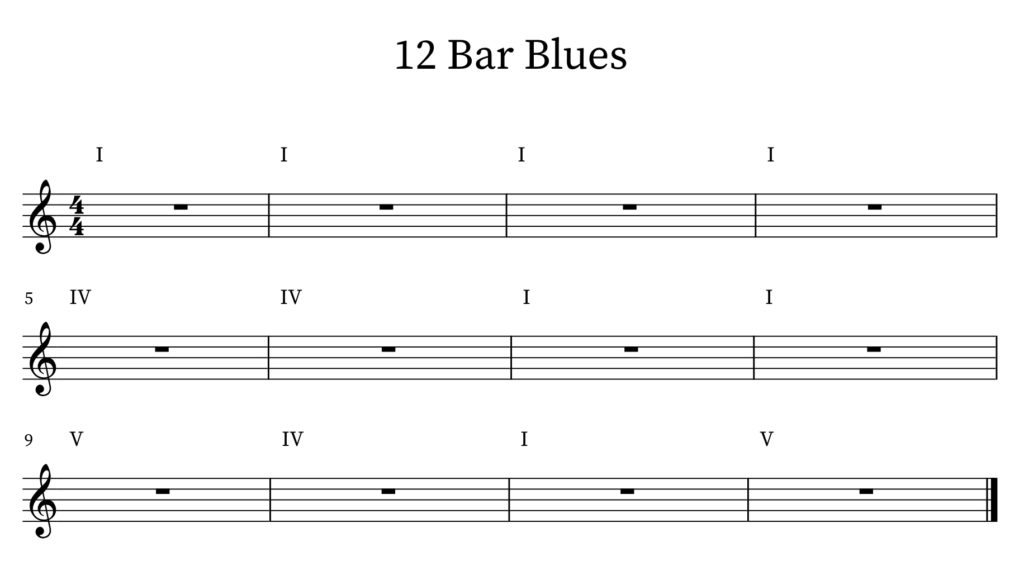
This provides you with the foundation for the 12 bar blues. You can then easily apply this structure to different keys.
So if you were to play a 12 bar blues in the key of C, using dominant 7th chords, it would look like this:

This is the starting point and standard 12 bar blues progression – the variations on which we will be looking at here in more detail.
The ‘quick change’
The first common variation on the 12 bar blues, is what is known as the ‘quick change’.
As you can see above, the first 4 bars of a 12 bar blues only focus on the I chord.
If you are playing a slow blues, these first 4 bars can drag on a little. This is especially true if you are playing straight chords and not adding any fills or embellishments to the chords.
To counter this, a lot of blues musicians make one simple change.
Instead of playing the I chord for 4 bars, they go up to the IV chord for the second bar, before returning to the I chord.
It’s a very simple change. But it is one that helps to break up the first 4 bars of music and make them more interesting for the listener.
A quick change looks like this in the first 4 bars of a 12 bars blues progression:

After these first 4 bars, the progression follows the normal 12 bar blues structure, as shown above.
This variation on the 12 bar blues appears in songs like ‘Before You Accuse Me‘ by Bo Diddley and ‘Boot Hill‘, by Stevie Ray Vaughan.
8 bar blues
This is arguably one of the most common variations on the 12 bar blues. The 8 bar blues is a shortened version of the chord progression, and it is typically formed in one of 2 ways.
The first of these is very simple. All you have to do is remove the first 4 bars of the standard 12 bar blues. In this variation, the 8 bar blues progression looks like this:
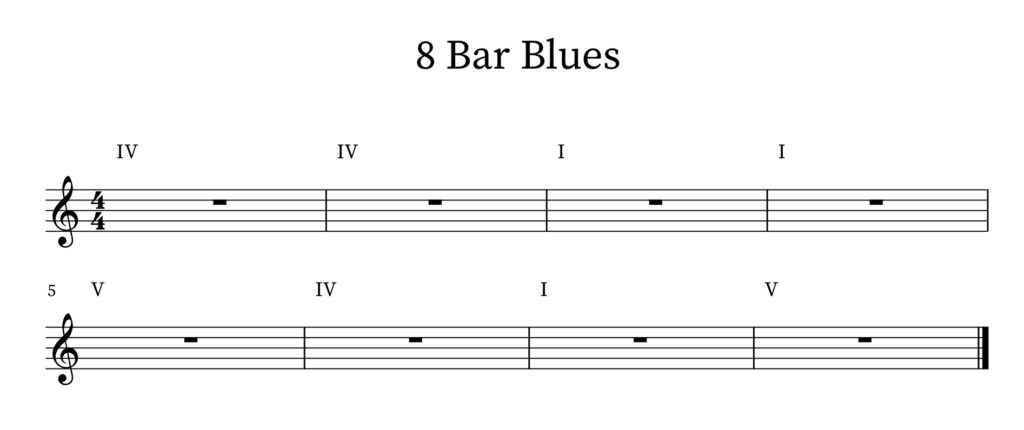
This form of the 8 bar blues is used in blues songs like ‘Love Me Like a Man‘ by Bonnie Raitt, and most famously in Buddy Guy’s ‘Mary Had a Little Lamb‘ (later covered by Stevie Ray Vaughan).
The second and more common form of the 8 bar blues, involves a different chord progression. The progression is still built around the I, IV and V chords, but the chords appear in a different order.
This order is as follows:
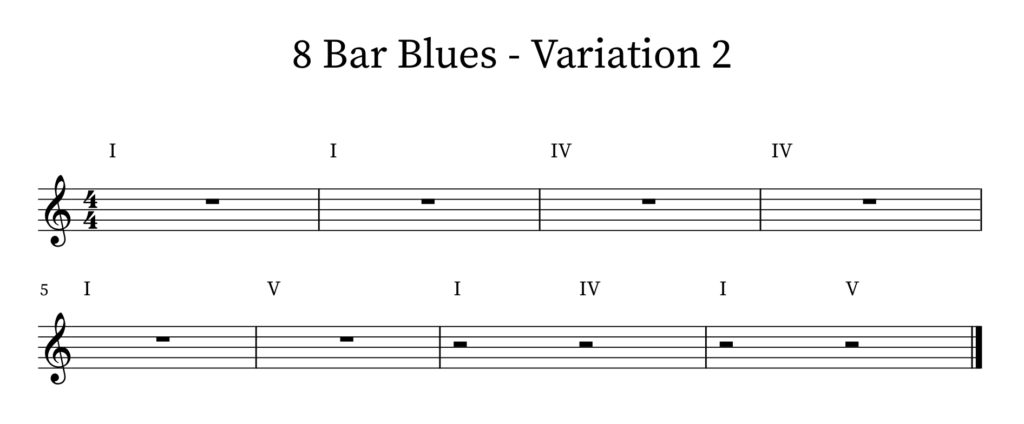
Unlike the 12 bar blues and the variations noted above, in this structure there are more changes between the chords. Not every chord is held for a full bar or measure.
So in the last 2 bars of this variation, you hold each chord for just half a bar.
You can hear this variation on the song ‘Worried Life Blues‘ – originally by Big Maceo Merriweather, but covered by a whole range of musicians, including Freddie King, B.B. King and Eric Clapton.
16 bar blues
The final variation on the 12 bar blues that we’ll cover here is the 16 bar blues. This is a nice and straight forward progression, that is most commonly created by extending either the 12 or 8 bar blues structures.
There are countless versions of this progression, but there are 2 forms that occur more frequently.
For the first of these, you just take the 12 bar blues and extend the first 4 bars of the progression for another 4 bars.
So instead of playing 4 bars of the I chord, in this form of the 16 bar blues you play 8 bars of the I chord. You then work through the rest of the 12 bar blues progression as normal.
This variation of the 12 bar blues looks like this:
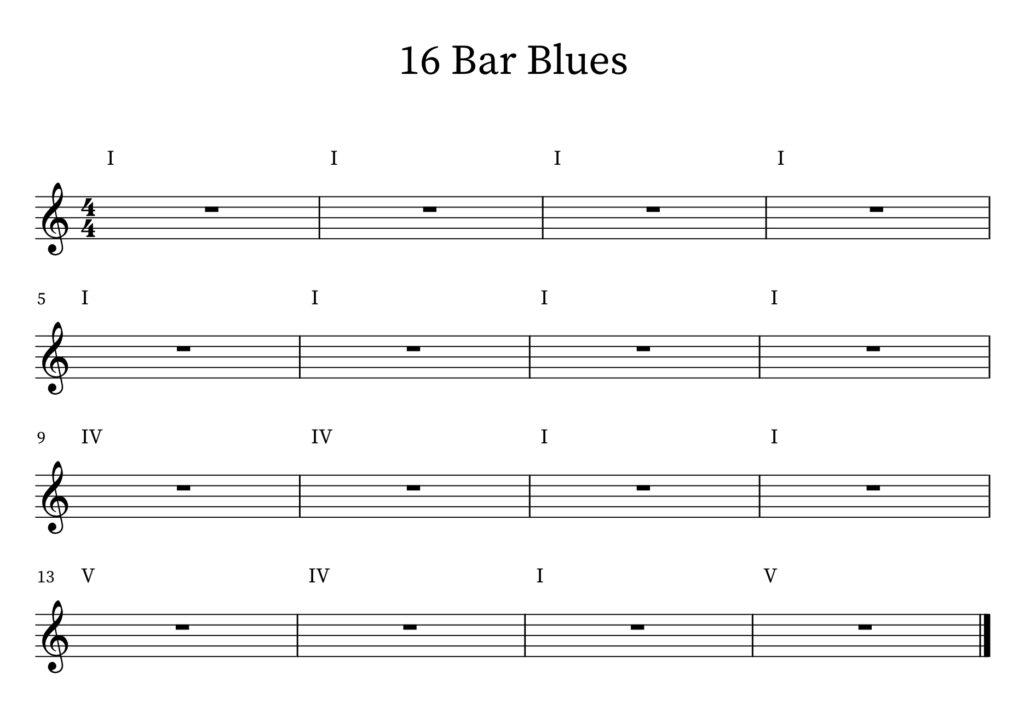
This form of the 16 bar blues appears in blues classics like ‘I’m Your Hoochie Coochie Man‘ by Muddy Waters and ‘Oh, Pretty Woman‘ by Albert King.
A second and very common version of the 16 bar blues repeats what is normally the middle section of a 12 bar blues.
In this variation, the 16 bar blues progression is as follows:
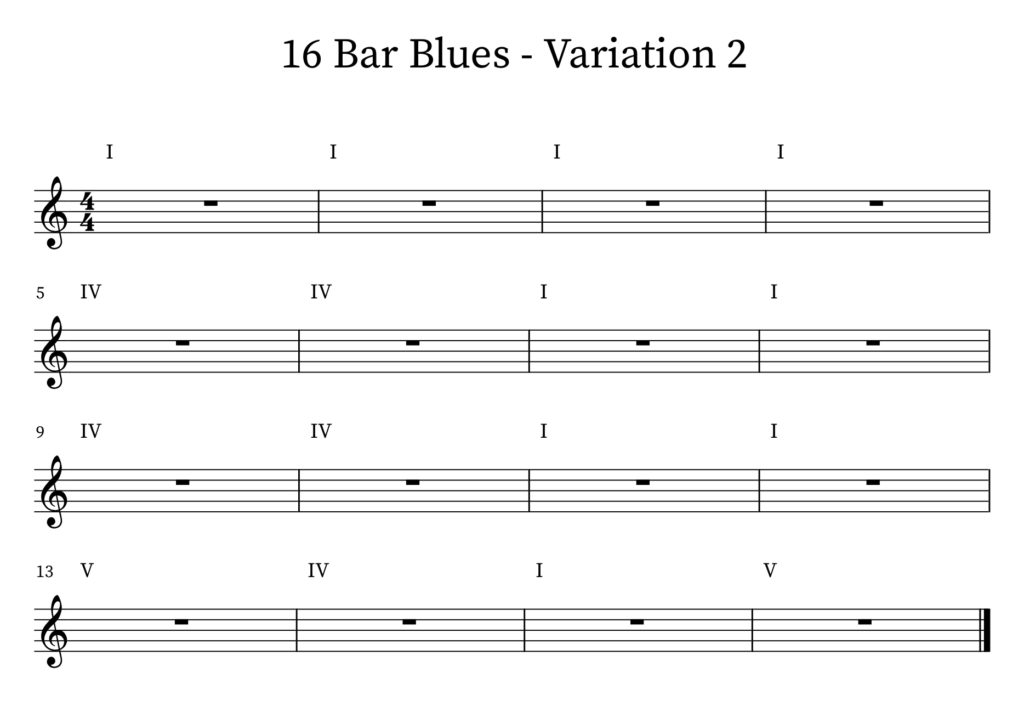
This progression appears on blues songs like ‘See See Rider‘ – performed by Lead Belly (amongst many others) as well as ‘Sleepy Time Time‘ by Cream.
Some closing thoughts
Well there we have it, some of the most common variations on the 12 bar blues.
Two of these variations – the 8 and 16 bar blues – are much more flexible in their structure. There are countless variations of these progressions – and far too many to include here.
As such, you can’t memorise just the one chord progression, as you may have done with the 12 bar blues.
Having the knowledge that these variations exist, and understanding some of the most common alternatives to the 12 bar blues will greatly improve your rhythm playing.
It will also prepare you for jamming with other musicians in a live setting.
So give these variations a go and let me know how you get on. And if you have any questions – just post them in the comments or send me an email on aidan@happybluesman.com.
Images
References
Anyone Can Play Guitar, Wikipedia, Fret Jam, Jamie Holroyd Guitar, Blues Guitar Institute





Responses
The chords in the bars 7 and 8 of the “12 Bar Blues in the Key of C” in “A Quick Recap” don’t match the standard 12 Bar Blues progression shown above.